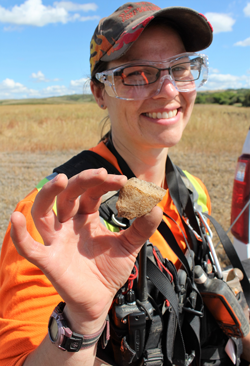 Archaeologists have unearthed what is believed to be an ancient bison bone from a historically significant area of Flagstaff County.
Archaeologists have unearthed what is believed to be an ancient bison bone from a historically significant area of Flagstaff County.
The discovery was made in a three-metre-deep trench dug up with an excavator Aug. 27 during excavation efforts near one of the County’s gravel pits.
“It’s more than likely a species of bison,” says Madeline Coleman, an archaeologist with Edmonton-based Tree Time Services Inc.
The lone bone, thought to be a portion of an adult bison’s radius, will be compared to ancient bison bones stored in a collection at the University of Alberta in Edmonton and is expected to undergo testing, “possibly carbon-dating,” adds Coleman.
Until then, its age won’t be certain. Theoretically, the bone could be anywhere from 300 to 13,000 years old.
“Human occupation in Alberta started around 11,000 B.C.,” Coleman explains. “As glaciers moved out of the province, people started moving in.”
Flagstaff County has agreed not to publicize the location of the bone find in order to discourage members of the public from conducting their own archaeological digs at the site. Under the Historical Resources Act, artifacts and other historic resources are property of the Crown, and citizens are prohibited from digging and collecting them without a permit.
The site is adjacent to one of the seven gravel pits that the County currently leases and manages. This particular pit was earmarked for expansion. But after it was discovered that the land fell within a “significant historical site” as recorded by the provincial government, the County notified Alberta Culture and Tourism as required under the Historical Resources Act.
Coleman and a fellow archaeologist with Tree Time Services, Elenore Hood, worked for four days at the site, conducting shovel tests, surface inspections and combing through soil excavated from three-metre test pits as part of their initial assessment.
 |
| Elenore Hood displays a lithic flake found near a Flagstaff County gravel pit. |
No other bones were found, but Coleman and Hood did collect and catalogue over 50 lithic flakes and three cores they found in other tests around the site. A lithic flake is a portion of rock that was removed from a cobble core in the fashioning of prehistoric weapons, such as arrowheads, and other tools.
There is no way to gauge the exact age of a lithic flake. All Coleman can say for certain is that the flakes are from a period of time prior to the 18th century when Europeans settled in the area.
The archaeologists are now completing an interim report to Alberta Culture and Tourism containing recommendations for further evaluation.
“We would like to do more testing just to see if anything else pops up, but that will depend on Alberta Culture,” Coleman adds.
“What we’d like to see is the area plowed because everything we’re finding is in the plow zone.”
The plow zone, she explains, is the top layer of the soil to the depth at which a plow will penetrate and disturb archeological deposits. She estimates the plow zone in this case is about 30 to 40 cm deep.
The area of interest is roughly 4.5 hectares, according to Coleman.
Within 10 km of the area, the provincial government has recorded 112 other historically significant sites that includes everything from isolated finds, such as ancient projectile points, and large prehistoric campsites to farmsteads, ranches and other historic structures dating back to the 19th century.
In the area, there are also a number of bison kill sites, where indigenous populations drove herds of bison off river margins and other topographical high points. It wasn’t the fall that would prove fatal, Coleman notes, but the impact of the bison falling on one another.
The Tree Time Services archaeologists expected to file their interim report with Alberta Culture and Tourism this week.
“We’re hoping to have an answer within two weeks,” Coleman notes.
As mandated by Alberta Culture and Tourism, the County has also contracted paleontologists to examine the area in the coming days.
To report an archaeological find made anywhere in Alberta, click HERE.
 |
| Image of the adult bison radius supplied by Tree Time Services Inc. |